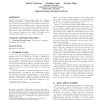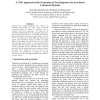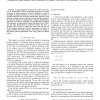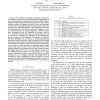92
Voted
WCC
2005
Springer
15 years 6 months ago
2005
Springer
In this paper, we discuss some methods of constructing frequency/time hopping (FH/TH) sequences over GF(pk ) by taking successive k-tuples of given sequences over GF(p). We are abl...
123
Voted
AADEBUG
2005
Springer
15 years 6 months ago
2005
Springer
AMPLE locates likely failure-causing classes by comparing method call sequences of passing and failing runs. A difference in method call sequences, such as multiple deallocation ...
105
Voted
MINENET
2005
ACM
15 years 6 months ago
2005
ACM
Increasingly powerful fault management systems are required to ensure robustness and quality of service in today’s networks. In this context, event correlation is of prime impor...
128
Voted
ASWEC
2005
IEEE
15 years 6 months ago
2005
IEEE
Starting with a UML specification that captures the underlying functionality of some given Java-based concurrent system, we describe a systematic way to construct, from this speci...
INFOSCALE
2006
ACM
15 years 7 months ago
2006
ACM
Abstract— Comparing genetic sequences is a well-known problem in bioinformatics. Newly determined sequences are being compared to known sequences stored in databases in order to ...
94
Voted
SSC
2007
Springer
15 years 7 months ago
2007
Springer
Any span n sequences can be regarded as filtering sequences. From this observation, new randomness criteria for span n sequences are proposed. It is proved that the feedback funct...
83
Voted
IJCNN
2007
IEEE
15 years 7 months ago
2007
IEEE
—Perception, prediction and generation of sequences is a fundamental aspect of human behavior and depends on the ability to detect serial order. This paper presents a plausible m...
107
click to vote
BIBE
2007
IEEE
15 years 7 months ago
2007
IEEE
Abstract—We consider the problem of aligning multiple protein sequences with the goal of maximizing the SP (Sum-of-Pairs) score, when the number of sequences is large. The QOMA (...
82
Voted
SIBGRAPI
2008
IEEE
15 years 7 months ago
2008
IEEE
This paper describes a method to estimate the temporal alignment between N unsynchronized video sequences captured by cameras with non-overlapping fields of view. The sequences a...
91
Voted
PIMRC
2008
IEEE
15 years 7 months ago
2008
IEEE
Abstract— In a slot-synchronized wireless communication system, a set of signature sequences can be derived by circularly shifting a base sequence with good auto correlation prop...






